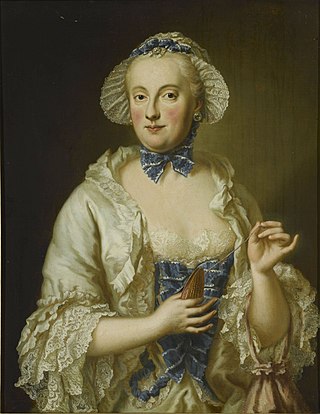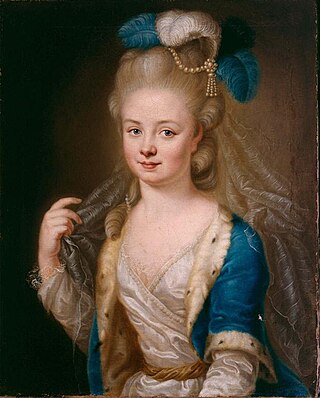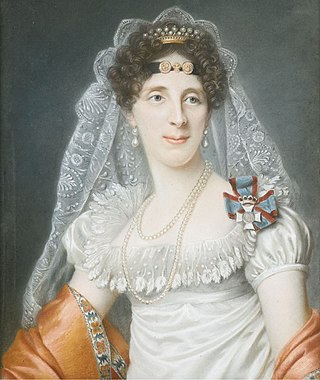
The House of Wittelsbach is a former Bavarian dynasty, with branches that have ruled over territories including the Electorate of Bavaria, the Electoral Palatinate, the Electorate of Cologne, Holland, Zeeland, Sweden, Denmark, Norway, Hungary, Bohemia, and Greece. Their ancestral lands of Bavaria and the Palatinate were prince-electorates, and the family had three of its members elected emperors and kings of the Holy Roman Empire. They ruled over the Kingdom of Bavaria which was created in 1805 and continued to exist until 1918.

Maximilian I Joseph was Duke of Zweibrücken from 1795 to 1799, prince-elector of Bavaria from 1799 to 1806, then King of Bavaria from 1806 to 1825. He was a member of the House of Palatinate-Birkenfeld-Zweibrücken, a branch of the House of Wittelsbach.

Charles Theodore was a German nobleman of the Sulzbach branch of the House of Wittelsbach. He became Count Palatine of Sulzbach from his father Johann Christian in 1733, at the age of six. With the death of his cousin, Charles III Philip, he became Prince-elector and Count Palatine of the Rhine in 1742, being eighteen. In his fifties, he became Prince-Elector of Bavaria at the death of another cousin, Maximilian III Joseph, in 1777.
Duke in Bavaria was a title used among others since 1506, when primogeniture was established, by all members of the House of Wittelsbach, with the exception of the Duke of Bavaria which began to be a unique position. So reads for instance the full title of the late 16th century's Charles I, Count Palatine of Zweibrücken-Birkenfeld and patriarch of the House of Palatinate-Birkenfeld: "Count Palatine by Rhine, Duke in Bavaria, Count to Veldenz and Sponheim". The title grew in importance as Wilhelm, Count Palatine of Zweibrücken-Birkenfeld-Gelnhausen began to use it, in the early 19th century, as his primary title – Duke Wilhelm in Bavaria. This choice has also had effect for his descendants.

The Duchy of Palatinate-Zweibrücken was a duchy of the Holy Roman Empire with full voting rights to the Reichstag. Its capital was Zweibrücken. The reigning house, a branch of the Wittelsbach dynasty, was also the Royal House of Sweden from 1654 to 1720.

Countess Palatine Maria Francisca of Sulzbach, was a Countess Palatine of Zweibrücken-Birkenfeld by marriage to Frederick Michael, Count Palatine of Zweibrücken-Birkenfeld.

Maria Anna Sophia of Saxony was a daughter of King Augustus III of Poland and his wife Maria Josepha of Austria who became Electress of Bavaria by marriage to Maximilian III Joseph, Elector of Bavaria.

Frederick Michael, Count Palatine of Zweibrücken-Birkenfeld was a member of the Wittelsbach dynasty. He was the son of Christian III of Palatinate-Zweibrücken and Caroline of Nassau-Saarbrücken and a member of the House of Palatinate-Zweibrücken-Birkenfeld, a branch of the House of Wittelsbach. He was the father of the Bavarian King Maximilian I Joseph. Furthermore, he engaged Nicolas de Pigage to reconstruct his summer palace in Oggersheim.

Christian IV, Count Palatine of Zweibrücken-Birkenfeld was Duke of Zweibrücken from 1735 to 1775.

Charles II August Christian was Duke of Zweibrücken from 1775 to 1795. A member of the Palatine House of Zweibrücken-Birkenfeld, a branch of the House of Wittelsbach, he was the elder brother of the first King of Bavaria, Maximilian I, and of Queen Amalia of Saxony.

The House of Palatinate-Birkenfeld, later Palatinate-Zweibrücken-Birkenfeld, was the name of a collateral line of the Palatine Wittelsbachs. The Counts Palatine from this line initially ruled over only a relatively unimportant territory, namely the Palatine share of the Rear County of Sponheim; however, their importance steadily grew. All living members of the House of Wittelsbach descend from Palatinate-Birkenfeld, which thus became the parent branch of the Kings of Bavaria.

Duke Pius August in Bavaria, full German name: Pius August Herzog in Bayern was a Duke in Bavaria as a member of the Palatine Birkenfeld-Gelnhausen line of the House of Wittelsbach. Pius August was a grandfather of Empress Elisabeth of Austria through his son Duke Maximilian Joseph in Bavaria, as well as a great grandfather of Queen Elisabeth of the Belgians and an ancestor of the current generations of the Belgian and Italian Royal Families and the Grand Ducal Family of Luxembourg.

Amalie of Zweibrücken-Birkenfeld-Bischweiler was the last Electress and first Queen of Saxony and Duchess of Warsaw.

Princess Amélie Louise Julie of Arenberg, (full German name: Amalie Luise Julie, Prinzessin und Herzogin von Arenberg and full French name: Amélie Louise, princesse et duchesse d'Arenberg, was a member of the House of Arenberg by birth and, through her marriage to Duke Pius August in Bavaria, a member of the Palatinate-Birkenfeld-Gelnhausen line of the House of Wittelsbach. Amélie Louise was a grandmother of Empress Elisabeth of Austria through her son Duke Maximilian Joseph in Bavaria.

Christiane Henriette of Palatinate-Zweibrücken-Birkenfeld was a Countess of Palatine of Zweibrücken-Birkenfeld by birth and by marriage a Princess of Waldeck-Pyrmont.

John Charles, Count Palatine of Birkenfeld at Gelnhausen, was a German prince and ancestor of the cadet branch of the royal family of Bavaria known, from the early 19th century, as Dukes in Bavaria. He took Gelnhausen as the name of his branch of the family after acquiring that estate in 1669.

John, Count Palatine of Gelnhausen was Count Palatine and Duke of Zweibrücken-Birkenfeld at Gelnhausen.

Countess Palatine Maria Anna of Zweibrücken-Birkenfeld-Bischweiler was Countess Palatine of Birkenfeld-Gelnhausen and Duchess in Bavaria, through her marriage to Duke Wilhelm in Bavaria. Maria Anna was a great-grandmother of Empress Elisabeth of Austria through her son Duke Pius August in Bavaria

Duchess Maria Elisabeth Amalie Franziska in Bavaria was a Duchess in Bavaria as a member of the Palatine Birkenfeld-Gelnhausen line of the House of Wittelsbach and through her marriage to Louis-Alexandre Berthier became Princess of Wagram and Princess of Neuchâtel.



















